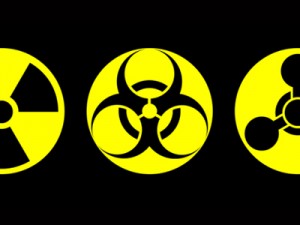 Syria appears to be quietly shifting some chemical weapons from storage sites, say Western and Israeli officials, but it is not clear whether the operation is merely a security precaution amid the chaos of war, or something more.
Syria appears to be quietly shifting some chemical weapons from storage sites, say Western and Israeli officials, but it is not clear whether the operation is merely a security precaution amid the chaos of war, or something more.
Some analysts see the move as serving a dual purpose – to keep the weapons from capture by an expanding insurgency, and to deprive Syria’s Western foes of any excuse for intervention on the grounds of securing dangerous material gone astray.
The Syrian government denies carrying out the operation, first reported by the Wall Street Journal, and there is no firm word on the materials involved. Syria’s undeclared stockpile reportedly includes sarin nerve agent, mustard gas and cyanide.
But the reports contribute to an impression of crumbling government control in parts of Syria, and are likely to heighten international concern about the security of what is believed to be the Middle East’s largest chemical weapons stockpile.
An Israeli official said however the movements reflected an attempt by President Bashar al-Assad to make “arrangements to ensure the weapons do not fall into irresponsible hands”.
“That would support the thinking that this matter has been managed responsibly so far.”
In Washington, a national security official confirmed the U.S. government had received reports of chemical weapons movements but was not sure of the reasons.
TIGHT CONTROL
A second U.S. official said the reported movements were “relatively new”, but not necessarily hugely frightening.
Pentagon spokesman George Little said Pentagon believed the Assad regime retained control of chemical weapons but the United States and its partners were watching closely.
“We would of course caution them (the Syrians) strongly against any intention to use those stockpiles. That would cross a serious red line,” he said.
“We cannot assume nefarious intent,” said Dina Esfandiary, a research analyst at London’s International Institue for Strategic Studies.
She said mustard gas, stored in weaponised form in artillery shells, could be used against “tactical targets” like advancing troops. “This is the reason why moving them looks suspicious – because it looks like he is moving them to be used, even though he could be moving them to more secure locations.”
Western countries believe Damascus has the world’s largest remaining stockpile of undeclared chemical weapons – including mustard gas and the deadly VX nerve agent. The arsenal could give Assad a means to project power domestically and in the region, and counterbalance Israel’s undeclared nuclear weapons.
In London, the British Foreign Office (ministry) said Syria was a country “of proliferation concern” and had a track record of covert weapons programmes.
From Israel’s point of view the biggest “red line” would be a transfer of such weaponry to the powerful Shi’ite political party and guerrilla group Hezbollah, a sworn foe.
More localised leakage within Syria would be less worrying as such weapons are not easy to operate in the absence of a military infrastructure, Israeli officials have said.
RESTIVE AREAS
But Damascus worries that even the appearance that it no longer enjoys 100 percent control of the material could trigger military action by the West to secure the sites and prevent them from getting into the hands of Islamist militants, analysts say.
“The material in question may not be adequately protected, or they are near restive areas,” said Shashank Joshi of the Royal United Services Institute military think tank.
Assad’s focus on the possibility that Western forces may one day seek to capture his chemical weapons may have been sharpened by the holding of regular multinational military exercises involving U.S. forces in neighbouring Jordan earlier this year.
Joshi said the U.S. had been training for that kind of operation with nuclear-armed Pakistan in mind, “and so the stories have been trickling out (from Jordan) in a very clear U.S. signaling that ‘we are preparing for this eventuality’. That will obviously have affected Assad.”
Western media reports have said suspected sites are in half a dozen cities and towns including the capital Damascus, Latakia, Hama and near Aleppo.
A senior Free Syrian Army source said two weeks ago that Assad’s forces, with Iranian help, were moving chemical weapons out of the the Tal Qartal military site, around 14 km (10 miles) southwest of Hama.
The source said some were going to Damascus and being airlifted to Lebanon. There was no immediate confirmation of the report.
FRONT LINES
Leonard S. Spector, director of the Washington office of the James Martin Center for Nonproliferation Studies research center, said there were several scenarios in which control could be lost over portions of the chemical arsenal.
Writing in a June 26 article in Yale Global Online, Spector listed these as:
– Custodians could be reassigned to the front lines of the impending civil war.
– They could desert posts to protect families as domestic turmoil continues.
– They could defect to the rebel cause, transferring control over weapons stocks to the Free Syrian Army, with confused lines of authority and plans to manage such materials that are likely non-existent.
– Depending on the ebb and flow of battle, Assad could abandon the custodians if, for example, the sites fell within swathes of territory taken by rebel forces.
– They could be overrun by rebel troops. Free Syria Army leaders might try to demonstrate, through capture of a site symbolizing Assad’s military strength, that the Syrian leader was losing his grip on power.
“In any of these chaotic settings, bribery, bargaining for passage out of the country or ideological commitment could lead remaining guardians to offer up assets under their control,” Spector wrote.
Reuters
Leave a Reply
You must be logged in to post a comment.